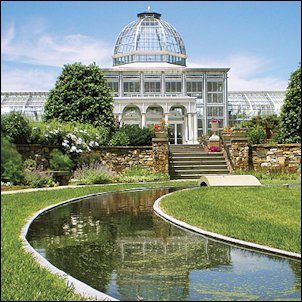by James A. Bacon
When a group of Richmond botanists, horticulturalists and interested citizens founded the Lewis-Ginter Botanical Garden in 1981, their vision was to plant formal, European-style gardens to rival the finest in the country. They succeeded in that goal beyond their expectations. Lewis Ginter is consistently rated as one of the Top 10 gardens in the United States. Of its 350,000 visitors in 2013, an estimated 20% to 30% came from outside the metropolitan region, making it the No. 2 visitor’s destination, after the Richmond International Raceway, in Henrico County.
President Frank Robinson, who joined the staff in 1992 and is planning to retire next year, could be forgiven for resting easy with that accomplishment. But he’s not. Society has changed over the past three decades, he says, and the organization has evolved along with it. The thrust of Lewis Ginter’s current $9 million fund-raising effort is not to build more formal landscaping worthy of coffee-table books, rather it represents a return to nature — or, more accurately, a reconciliation of urban development with nature.
The Streams of Stewardship initiative challenges expectations of what landscape design should be. Conventional Virginia tastes are heavily influenced by a heritage of gardens designed for French kings and English aristocrats from a very different era. But the challenges of 21st century America call for something new. The introduction of foreign ornamental plants and the voracious consumption of land by 20th- and 21st-century suburbs stresses Virginia’s natural environment, sterilizing the habitat for wildlife and polluting streams and rivers with fertilizers, herbicides and pesticides. A new landscaping aesthetic can reverse some of the damage.
Lewis Ginter’s intention is to transform the 30 acres not dedicated to formal gardens on the 80-acre site with two goals in mind: to show how landscaping can clean creeks and streams polluted by urban run-off and to re-establish indigenous plants that support local wildlife. Plans call for replacing acres of formal grass lawn and large mulched beds with ornamental grasses and shrubs. A native plant garden will be established along a restored stream, and a woodland garden will provide natural filtration for excess nitrogen, phosphates and other algae-feeding nutrients flowing from a neighboring subdivision, a nearby golf course and Lewis-Ginter’s own property.
As Executive Director Shane Tippett puts it, Lewis Ginter wants to demonstrate that it is possible to meet a triple bottom line of creating beautiful places, restoring the environment, and doing so economically.
It’s not enough to show that such things can be done: The garden also wants to drive aesthetic and cultural change in the Richmond region, educating its 350,000 annual visitors, connecting with local landscapers and horticulturalists and reaching out to developers and home builders. In sum, the botanical gardens want to be a resource for the community.
The organization has largely fulfilled its core mission, says Robinson. “We knew we had to create very fine gardens to draw people here. And we had to generate earned income to support the enterprise.” And that it has done. The gardens are magnificent, and people are drawn year-round by a series of events: beautiful tulips in the springs, light displays at night, bonfires, jazz concerts, hot chocolate and the like. “Ultimately, it’s about the aesthetics. We had to do that to build the brand, the audience. We wouldn’t have been so successful if we’d started with a field of native grasses.”
The garden leadership began moving toward the new vision a decade ago, starting with a $1 million investment in a system that collected rainwater from building roofs and funneled it into two lakes on the property. Except for one year of severe drought, the property no longer needs county water. Avoiding the consumption of more than 7 million gallons a year saves Lewis Ginter hundreds of thousands of dollars annually in water bills and frees up county water capacity for someone else. The investment paid for itself in three or four years.
The 2007-2008 recession put the “Streams of Stewardship” fund-raising on hold but Richmond’s philanthropic community has revived to the point where Lewis Ginter is getting new commitments. Rather than waiting for the full $9 million to start, Robinson says, the garden is phasing in pieces of the plan as money comes available.
Meanwhile, the garden is taking an increasing leadership role in the community. It has invited to speak Lynden Miller, a nationally recognized garden designer, to Richmond, and Doug Tallamy, author of “Bringing Nature Home,” author of a treatise on how home gardeners can restore indigenous species. Its Beautiful RVA program brings together tree lovers, gardeners and landscapers to share ideas and build enthusiasm for creating quality public places.
“We never wanted to become a monastic community,” says Robinson. “It’s a big city out there. We can impact so many people beyond this property.”
This is the first of a planned series on the Lewis-Ginter Botanical Garden to be published as time permits.




